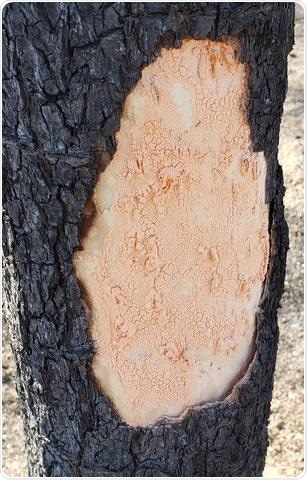Dec 17 2020
According to a new study led by the University of California, Riverside, the same proteins responsible for enabling human senses, like smell, also enable some fungi to sense things they can consume.

Neurospora fungus growing on a tree trunk after the recent Cima Dome fire in the Mojave desert. Image Credit: Alex Carillo/UCR.
The study opens novel ways to safeguard people from starvation caused by food shortages induced by a pathogenic fungus. Moreover, insights into how fungi sense and digest plants can help researchers design new fungal strains that are more efficient at synthesizing biofuels.
The study was recently published in mBio journal, from the American Society for Microbiology, and describes how fungi react to cellulose, the main constituent of plant cell walls. Although humans and other animals do not have the enzymes to digest cellulose, fungi can transform it into glucose—a sugar that is a superior biofuel feedstock.
G proteins are vital to this conversion process and transmit signals from the outer membrane of a cell into its nucleus.
These proteins get information about what’s outside the cell into what is essentially the brain of the cell, the nucleus, which in turn instructs the cell to produce a cocktail of cellulose-digesting enzymes.”
Logan Collier, Study Author and Biochemistry Doctoral Student, University of California, Riverside
To find whether G proteins have a role to play in the potential of the fungi to sense nearby cellulose, the team modified strains of a fungus named Neurospora crassa. As soon as the G proteins were mutated, Neurospora could no longer “see” that it was on cellulose.
Neurospora is a filamentous fungus, that is, it is formed of thin tubes extending and forming a mesh when it grows. It recycles carbon by ingesting decaying plant matter and transforming it into glucose, thus playing a crucial role in the environment.
Moreover, it is closely associated with pathogenic fungi that destroy crops like wheat and tomatoes. One associated species also causes rice blast, which tends to destroy rice sufficient to feed nearly 80 million people per year.
Finding ways to interfere with G protein signaling in the fungus, and thereby preventing it from detecting its “food,” could thus be vital to arresting infections of these types.
No one has previously examined every member of the signaling pathway, creating a model for how every all of the G proteins work together.”
Katherine Borkovich, Study Lead and Professor of Microbiology and Plant Pathology, University of California, Riverside
As a next step, the researchers also plan to apply the insights they have gained to synthesizing biofuel.
“It does appear from our study that there are ways to modify the fungus to produce extra cellulose-digesting enzymes, which would make them more efficient at breaking down biofuel feedstocks,” stated Collier. Depending on renewable sources, such as plants, biofuels could play a crucial role in minimizing the reliance on fossil fuels.
Source:
Journal reference:
Collier, L. A., et al. (2020) Heterotrimeric G-Protein Signaling Is Required for Cellulose Degradation in Neurospora crassa. mBio. doi.org/10.1128/mBio.02419-20.